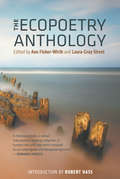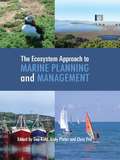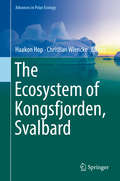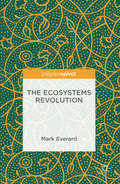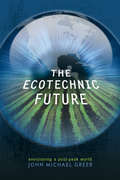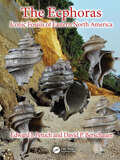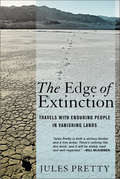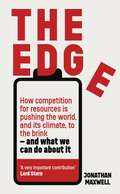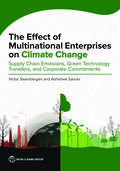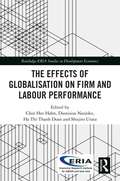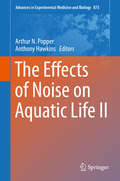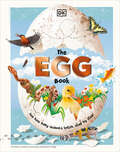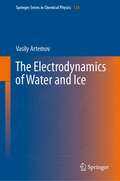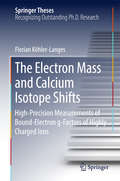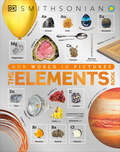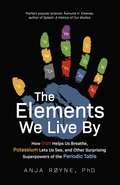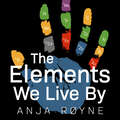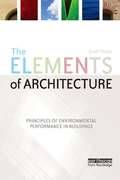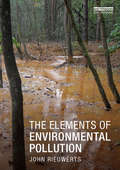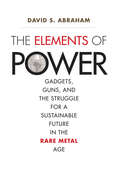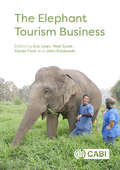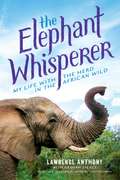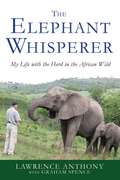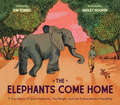- Table View
- List View
The Ecopoetry Anthology
by Robert Hass Laura-Gray Street Ann Fisher-WirthDefinitive and daring, The Ecopoetry Anthology is the authoritative collection of contemporary American poetry about nature and the environment--in all its glory and challenge. From praise to lament, the work covers the range of human response to an increasingly complex and often disturbing natural world and inquires of our human place in a vastness beyond the human.To establish the antecedents of today's writing,The Ecopoetry Anthology presents a historical section that includes poetry written from roughly the mid-nineteenth to the mid-twentieth century. Iconic American poets like Walt Whitman and Emily Dickinson are followed by more modern poets like Wallace Stevens, William Carlos Williams, Ezra Pound, and even more recent foundational work by poets like Theodore Roethke, Elizabeth Bishop, Robert Hayden, and Muriel Rukeyser. With subtle discernment, the editors portray our country's rich heritage and dramatic range of writing about the natural world around us.
The Ecosystem Approach to Marine Planning and Management (Earthscan Oceans)
by Sue Kidd Andy Plater Chris FridThe marine environment is one of our most precious yet fragile natural resources. It provides a wide range of essential goods and services, including food, regulation of climate and nutrient cycling, as well as a setting for transport, recreation and tourism. This environment is however extremely complex and very sensitive to development pressures and other forms of human influence. Planning and management of the sea are similarly complicated, reflecting intricate legal, institutional and ownerships patterns. This creates a situation where marine ecosystems are vulnerable to over-exploitation or neglect. The Ecosystem Approach to Marine Planning and Management describes how growing concern about the state of our seas is resulting in the development of new approaches to marine planning and management. For example, the United Nations Environment Programme has called for the widespread introduction of Marine Spatial Planning (MSP), and the European Union has recently been consulting on a new European Maritime Policy designed to stimulate economic growth but at the same time protect the resource base. Within the United Kingdom, the 2010 Marine Act draws upon the experience of town and country planning and brings into being a new system of Marine Spatial Planning. The authors show that a common feature of all these developments is an appreciation that more integrated forms of planning and management are required for our seas and that new arrangements must draw together understanding from natural science, social science and many other perspectives. Adopting such a trans-disciplinary and holistic (or 'ecosystems') approach, the book distils the expertise of these different disciplines and seeks to promote a broader understanding of the origins and practicalities of new approaches to marine planning and management.
The Ecosystem of Kongsfjorden, Svalbard (Advances in Polar Ecology #2)
by Christian Wiencke Haakon HopThis book focuses in detail on all ecologically important aspects of the Kongsfjorden system such as the marine and atmospheric environment including long-term monitoring, Ecophysiology of individual species, structure and function of the ecosystem, ecological processes and biological communities.The contributed articles include review articles and research articles that have a wider approach and bring the current research up-to-date. This book will form a baseline for future work.
The Ecosystems Revolution
by Mark EverardThis book explores humanity's relationship with the natural world throughout evolutionary history, and the need to reorient this onto a symbiotic basis. It integrates the themes of natural and artificial selection, the characteristics of historic 'revolutions', and directed versus random change. Inspiring community-based projects, mainly from the developing world, show how ecosystem regeneration uplifts human livelihoods in a positively reinforcing cycle, embodying lessons germane to co-creating a Symbiocene era wherein humanity's substantial influence (the Anthropocene) achieves increasing symbiosis with the natural processes shaping the former Holocene epoch. The Ecosystems Revolution provides practical, positive examples, highlighting the attainability of an 'ecosystems revolution'.
The Ecotechnic Future
by John Michael Greer"[John Michael] Greer's work is nothing short of brilliant. He has the multidisciplinary smarts to deeply understand our human dilemma as we stand on the verge of the inevitable collapse of industrialism. And he wields uncommon writing skills, making his diagnosis and prescription entertaining, illuminating, and practically informative. Not to be missed."--Richard Heinberg, Senior Fellow, Post Carbon Institute and author of Peak Everything"There is a great deal of conventional wisdom about our collective ecological crisis out there in books. The enormous virtue of John Michael Greer's work is that his wisdom is never conventional, but profound and imaginative. There's no one who makes me think harder, and The Ecotechnic Future pushes Greer's vision, and our thought processes in important directions." --Sharon Astyk, farmer, blogger, and author of Depletion and Abundance and A Nation of Farmers "In The Ecotechnic Future, John Michael Greer dispels our fantasies of a tidy, controlled transition from industrial society to a post-industrial milieu. The process will be ragged and rugged and will not invariably constitute an evolutionary leap for the human species. It will, however, offer myriad opportunities to create a society that bolsters complex technology which at the same time maintains a sustainable interaction with the ecosystem. Greer brilliantly inspires us to integrate the two in our thinking and to construct local communities which concretely exemplify this comprehensive vision." --Carolyn Baker, author of Sacred Demise: Walking The Spiritual Path of Industrial Civilization's Collapse, and publisher/editor, Speaking Truth to PowerIn response to the coming impact of peak oil, John Michael Greer helps us envision the transition from an industrial society to a sustainable ecotechnic world--not returning to the past, but creating a society that supports relatively advanced technology on a sustainable resource base.Fusing human ecology and history, this book challenges assumptions held by mainstream and alternative thinkers about the evolution of human societies. Human societies, like ecosystems, evolve in complex and unpredictable ways, making it futile to try to impose rigid ideological forms on the patterns of evolutionary change. Instead, social change must explore many pathways over which we have no control. The troubling and exhilarating prospect of an open-ended future, he proposes, requires dissensus--a deliberate acceptance of radical diversity that widens the range of potential approaches to infinity.Written in three parts, the book places the present crisis of the industrial world in its historical and ecological context in part one; part two explores the toolkit for the Ecotechnic Age; and part three opens a door to the complexity of future visions.For anyone concerned about peak oil and the future of industrial society, this book provides a solid analysis of how we got to where we are and offers a practical toolkit to prepare for the future.John Michael Greer is a certified Master Conserver, organic gardener, and scholar of ecological history. He blogs at The Archdruid Report (www.thearchdruidreport.blogspot.com), and is the author ofThe Long Descent.
The Ecphoras: Iconic Fossils of Eastern North America
by Edward J. Petuch David P. BerschauerIn the Miocene and Pliocene fossil shell beds of the eastern United States, the single most spectacular molluscan species radiation is seen in the ecphora shells (the Tribe Ecphorini). These bizarrely shaped gastropods, with their distinctive ribbed shell sculpture, represent a separate branch of the Subfamily Ocenebridae, Family Muricidae. Characteristically, these muricid gastropods are heavily ornamented with spiral ribs and cords and are considered some of the most beautiful and interesting groups of fossil mollusks found along the Atlantic Coastal Plain and Floridian Peninsula. The ecphoras are greatly sought after by fossil collectors. The ecphora faunas, and their individual species and subspecies, are illustrated and described in detail, along with photographs of ecphora-bearing geological units and in-situ specimens. The authors list the 67 known species and subspecies that are recognized as valid, arranged by the eight genera and five subgenera that encompass these taxa.
The Edge of Extinction: Travels with Enduring People in Vanishing Lands
by Jules PrettyIn The Edge of Extinction, Jules Pretty explores life and change in a dozen environments and cultures across the world, taking us on a series of remarkable journeys through deserts, coasts, mountains, steppes, snowscapes, marshes, and farms to show that there are many different ways to live in cooperation with nature. From these accounts of people living close to the land and close to the edge emerge a larger story about sustainability and the future of the planet. Pretty addresses not only current threats to natural and cultural diversity but also the unsustainability of modern lifestyles typical of industrialized countries. In a very real sense, Pretty discovers, what we manage to preserve now may well save us later. Jules Pretty's travels take him among the Maori people along the coasts of the Pacific, into the mountains of China, and across petroglyph-rich deserts of Australia. He treks with nomads over the continent-wide steppes of Tuva in southern Siberia, walks and boats in the wildlife-rich inland swamps of southern Africa, and experiences the Arctic with ice fishermen in Finland. He explores the coasts and inland marshes of eastern England and Northern Ireland and accompanies Innu people across the taiga’s snowy forests and the lakes of the Labrador interior. Pretty concludes his global journey immersed in the discrete cultures and landscapes embedded within the American landscape: the small farms of the Amish, the swamps of the Cajuns in the deep South, and the deserts of California. The diverse people Pretty meets in The Edge of Extinction display deep pride in their relationships with the land and are only willing to join with the modern world on their own terms. By the examples they set, they offer valuable lessons for anyone seeking to find harmony in a world cracking under the pressures of apparently insatiable consumption patterns of the affluent.
The Edge: How competition for resources is pushing the world, and its climate, to the brink – and what we can do about it.
by Jonathan MaxwellWe live in a World which, though the origins are long, seems suddenly transformed by economic events way out of our control. In seeking stability, we must acknowledge the seismic scale of the challenge, and understand the devastating impact of global energy inefficiency. Every society, organisation, business, household and individual must put efficiency first - not just to save money and carbon and improve resilience, but to reduce the risk, or effect, of conflict.THE EDGE is a very contemporary look at how the world has been transformed by recent economic events, focusing on climate change, the war in Ukraine, the Chinese economy and the challenges the world faces around inflation, energy, transport, fuel, imports etc. Written from an economist/investor's perspective, with lessons for pretty much every institution challenged by these developments, it is a timely and essential resource authored by a global expert with peerless connections, from major organisations to government insiders, from investors to energy corporations. It will help businesses and economies currently at the mercy of the markets to transition towards sustainability, productivity and prosperity, and help everyone understand the world in 2023.
The Effect of Multinational Enterprises on Climate Change: Supply Chain Emissions, Green Technology Transfers, and Corporate Commitments (Climate Change and Development)
by Victor Steenbergen Abhishek SauravMultinational enterprises (MNEs) provide both a fundamental risk to and an opportunity for climate change mitigation. The climate ambitions of MNEs will affect the environmental performance of countries around the world. As a leading actor, proactive MNEs can impose sustainability standards or encourage green technology transfers that, in some cases, could affect millions of producers and accelerate the climate transition. However, obstructive MNEs may equally hold back any progress to reduce a country's emissions via inaction or by actively resisting, obstructing, or lobbying against change. The objective of this report is to study the effect of MNEs on climate change. Toward this goal, the report reviews the latest available data, conducts new empirical analysis, and summarizes pioneering literature. The report answers four key questions related to the relationship between MNEs and climate change: 1) What effect do MNEs currently have on climate change, both through their own activities and through the emissions of their broader supply chains?; 2) How do MNEs shape the potential transfer of green technologies to domestic firms, and how do different types of interactions with MNEs stimulate such technology transfers?; 3) How committed are leading MNEs currently to transitioning their supply chains to net-zero emissions by 2050, and do they have long-, medium-, and short-range strategies to realize this?; 4) What types of policies can influence MNEs' effects on climate change?
The Effects of Globalisation on Firm and Labour Performance (Routledge-ERIA Studies in Development Economics)
by Shujiro Urata Dionisius Narjoko Chin Hee Hahn Ha Thi Thanh DoanThis book examines driving factors and the effects of globalisation on economic development through firm and product-level data. The book is organised into four themes, i.e., productivity, innovation, wage and income gap, and within-firm reallocation of resources. The comprehensiveness and richness of firm and product-level data shed light upon the channels through which trade and investment affect firms’ competitiveness and unveil factors shaping firms’ heterogeneous responses towards globalisation. The book looks at Asian economies as well as Australia and how they have experienced substantial structural change and become more integrated into the global economy and will be a useful reference for those who are interested in learning more about the relationship between globalisation and firm performance. This book will appeal to policy makers and researchers interested in the impact of globalisation on firm performance.
The Effects of Noise on Aquatic Life II
by Arthur N. Popper Anthony HawkinsThe meeting of Aquatic Noise 2013 will introduce participants to the most recent research data, regulatory issues and thinking about effects of man-made noise and will foster critical cross-disciplinary discussion between the participants. Emphasis will be on the cross-fertilization of ideas and findings across species and noise sources. As with its predecessor, The Effects of Noise on Aquatic Life: 3rd International Conference will encourage discussion of the impact of underwater sound, its regulation and mitigation of its effects. With over 100 contributions from leading researchers, a wide range of sources of underwater sound will be considered.
The Egg Book: See How Baby Animals Hatch, Step By Step!
by DKLearn about the remarkable beginnings of life with this adorable book of baby animals hatching from their eggs.Find out all about how eggs hatch step by step in this fascinating baby animal book for children. Many animals start life inside eggs and this book explores these magical capsules in detail, with stunning photographs of the moment the creatures emerge.Featuring more than 20 animals – including a penguin, a tortoise, and even a slug – this book documents the moment of hatching in detail. Children aged 5-7 can learn how birds, reptiles, amphibians, fish, and invertebrates hatch from their eggs, as well as what happens inside an egg&’s shell.This captivating animal book for children features: - A step-by-step account of different types of animals hatching, as well as what an egg is, which animals have eggs, and what is inside an egg.- Introductory pages that explain which animals have eggs and how they work.- Large, detailed photographs show eggs hatching almost in real-time.- A wide range of animals, from birds to amphibians and insects.With expert information, jaw-dropping photography, and a beautifully shiny foil finish, The Egg Book is the ideal gift for any child with a love of nature and baby animals. Children will love to see the biggest egg in the world hatching, find out which animals have jellylike eggs, and which animals&’ egg cases are known as &“mermaids&’ purses&”.
The Electrodynamics of Water and Ice (Springer Series in Chemical Physics #124)
by Vasily ArtemovThis book is a research monograph summarizing recent advances related to the molecular structure of water and ice, and it is based on the latest spectroscopic data available. A special focus is given to radio- and microwave frequency regions. Within the five interconnected chapters, the author reviews the electromagnetic waves interaction with water, ice, and moist substances, discussing the microscopic mechanisms behind the dielectric responses. Well-established classic views concerning the structure of water and ice are considered along with new approaches related to atomic and molecular dynamics. Particular attention is given to nanofluidics, atmospheric science, and electrochemistry. The mathematical apparatus, based on diverse approaches employed in condensed matter physics, is widely used and allows the reader to quantitatively describe the electrodynamic response of water and ice in both bulk and confined states. This book is intended for a wide audience covering physicists, electrochemists, geophysicists, engineers, biophysicists, and general scientists who work on the electromagnetic radiation interaction with water and moist substances.
The Electron Mass and Calcium Isotope Shifts
by Florian Köhler-LangesThis thesis presents the first isotope-shift measurement of bound-electron g-factors of highly charged ions and determines the most precise value of the electron mass in atomic mass units, which exceeds the value in the literature by a factor of 13. As the lightest fundamental massive particle, the electron is one of nature’s few central building blocks. A precise knowledge of its intrinsic properties, such as its mass, is mandatory for the most accurate tests in physics - the Quantum Electrodynamics tests that describe one of the four established fundamental interactions in the universe. The underlying measurement principle combines a high-precision measurement of the Larmor-to-cyclotron frequency ratio on a single hydrogen-like carbon ion studied in a Penning trap with very accurate calculations of the so-called bound-electron g-factor. For the isotope-shift measurement, the bound-electron g-factors of two lithium-like calcium isotopes have been measured with relative uncertainties of a few 10^{-10}, constituting an as yet unrivaled level of precision for lithium-like ions.
The Elements Book: A Visual Encyclopedia of the Periodic Table (DK Our World in Pictures)
by DKPacked with more than 1,000 incredible images and full of fascinating facts, this children&’s book takes you on a visual and vibrant journey of all the chemical elements that make up our world. This eye-catching encyclopedia for kids is the perfect guide to the 118 chemical elements of the periodic table, for budding young scientists to explore. It explores the naturally occurring elements, as well as the man-made ones, and explains their properties and uses. This engaging encyclopedia for children aged 9-12, shows the many natural forms of each element, as well as a wide range of both everyday and unexpected objects in which it is found, making each element relevant to the child&’s world!Celebrate your child's curiosity as they explore:- Striking and detailed diagrams, drawings and illustrations on every page- A highly visual approach to learning - Ideal combination of colorful diagrams with infographic text boxes- Showcases chemical elements in their pure and raw forms- In association with The Smithsonian InstitutionThis captivating kids encyclopedia takes a look at all 118 elements on the periodic table, from Hydrogen to Helium, Potassium to Polonium, calcium to carbon and so much more! The striking illustrations, photographs and diagrams featured throughout provide an optimum visual learning experience for both children and adults alike, accompanied by an array of fun facts all about your favorite elements, and lesser-known ones like Terbium, Thallium and Boron - with easy-to-read accessible text for readers aged 9-12, yet can be enjoyed by the entire family, making this enthralling children&’s encyclopedia a beautiful and educational gift that can be passed down generations.Learn all about the world one picture at a time!If you like The Elements Book then why not complete the collection? Part of the highly visual Our World In Pictures series, avid readers can dive into the world of dinosaurs with The Dinosaur Book, become a vehicle virtuoso with Cars, Trains, Ships and Planes and venture on a journey across the globe with Countries, Cultures, People & Places.
The Elements We Live By: How Iron Helps Us Breathe, Potassium Lets Us See, and Other Surprising Superpowers of the Periodic Table
by Anja RøyneWINNER OF THE 2018 BRAGE PRIZE'[T]his lovely book. An enjoyable sweep through topics ranging from respiration to space exploration -solid science presented in an engagingly human way' Andrew Crumey, author of The Great Chain of Unbeing'Perfect popular science . . . not just a well-written story about the elements, but a book about being human in the world today'Åsmund H. Eikenes, author of Splash: A History of Our BodiesWe all know that we depend on elements for survival - from oxygen in the air we breathe to carbon in the molecular structures of all living things. But we seldom appreciate how, say, phosphorus holds our DNA together or how potassium powers our optic nerves enabling us to see.Physicist and award-winning author Anja Røyne takes us on an astonishing journey through chemistry and physics, introducing the building blocks from which we humans - and everything else in the world - are made. Not only does Røyne explain why our bodies need iron, phosphorus, silicon, potassium and many more elements in just the right amounts in order to function, she also shows us where in the world these precious elements are found (some of them in limited and quickly depleting quantities).Røyne helps us understand how precariously balanced our lives - and ways of living - really are, and to appreciate little known and generally unsung heroes of the periodic table in an entirely new light.
The Elements We Live By: How Iron Helps Us Breathe, Potassium Lets Us See, and Other Surprising Superpowers of the Periodic Table
by Anja RøyneWINNER OF THE 2018 BRAGE PRIZE'[T]his lovely book. An enjoyable sweep through topics ranging from respiration to space exploration -solid science presented in an engagingly human way' Andrew Crumey, author of The Great Chain of Unbeing'Perfect popular science . . . not just a well-written story about the elements, but a book about being human in the world today'Åsmund H. Eikenes, author of Splash: A History of Our BodiesWe all know that we depend on elements for survival - from oxygen in the air we breathe to carbon in the molecular structures of all living things. But we seldom appreciate how, say, phosphorus holds our DNA together or how potassium powers our optic nerves enabling us to see.Physicist and award-winning author Anja Røyne takes us on an astonishing journey through chemistry and physics, introducing the building blocks from which we humans - and everything else in the world - are made. Not only does Røyne explain why our bodies need iron, phosphorus, silicon, potassium and many more elements in just the right amounts in order to function, she also shows us where in the world these precious elements are found (some of them in limited and quickly depleting quantities).Røyne helps us understand how precariously balanced our lives - and ways of living - really are, and to appreciate little known and generally unsung heroes of the periodic table in an entirely new light.
The Elements of Architecture: Principles of Environmental Performance in Buildings
by Scott DrakeThe Elements of Architecture is a clear and well structured introduction to sustainable architecture, which concentrates on general principles to make an accessible and comprehensive primer for undergraduate students. The author takes a fresh and logical approach, focusing on the way aspects of the built environment are experienced by the occupants and how that experience is interpreted in architectural design. He works through basic elements and senses (sun; heat; light; sound; air; water and fire) to explain and frame effective environmental architectural design - not only arguing that the buildings we inhabit should be viewed as extensions of our bodies that interact with and protect us from these elements, but also using this analogy to explain complex ideas in an accessible manner.
The Elements of Environmental Pollution
by John RieuwertsEnvironmental pollution is one of humanity’s most pressing issues and will remain so for the foreseeable future. Anthropogenic activity is disturbing natural cycles and generating pollutants that are altering the atmosphere, accumulating in the food chain and contaminating the world’s soils, rivers and oceans. Human health and ecosystems continue to be damaged by toxic metals, persistent organic pollutants, radionuclides and other hazardous materials. The Elements of Environmental Pollution provides comprehensive coverage of this essential subject. It explains the key principles of pollution science, assesses human disturbances of natural element cycles and describes local and global pollution impacts, from smoggy cities, polluted lakes and toxic soils to climate change, ocean acidification and marine dead zones. The book is informed by the latest pollution research and benefits from numerous real-world examples and international case studies. A comprehensive glossary provides clear and concise explanations of key concepts. This textbook will support teaching and learning in environment-related university courses and will be vital reading for anyone with an interest in environmental protection.
The Elements of Power
by David S. AbrahamOur future hinges on a set of elements that few of us have even heard of. In this surprising and revealing book, David S. Abraham unveils what rare metals are and why our electronic gadgets, the most powerful armies, and indeed the fate of our planet depend on them. These metals have become the building blocks of modern society; their properties are now essential for nearly all our electronic, military, and "green" technologies. But their growing use is not without environmental, economic, and geopolitical consequences. Abraham traces these elements' hidden paths from mines to our living rooms, from the remote hills of China to the frozen Gulf of Finland, providing vivid accounts of those who produce, trade, and rely on rare metals. He argues that these materials are increasingly playing a significant role in global affairs, conferring strength to countries and companies that can ensure sustainable supplies. Just as oil, iron, and bronze revolutionized previous eras, so too will these metals. The challenges this book reveals, and the plans it proposes, make it essential reading for our rare metal age.
The Elephant Tourism Business
by Eric Laws Anja Pabel Rebecca Winkler Clive Phillips Eric Brymer Andrew McLean Professor Noel Scott Melville Saayman Daniel Turner Professor Xavier Font Mucha Mkono Ann Suwaree Ashton Liv Baker Sumanth Bindumadhav Sarah Blaine Naphawan Chantradoan Saranphat Chotmanakul Qingming Cui Susanna Curtin Charlotte Day Nilakshi Galahitiyawe Vivek Gurusamy Nicole Hausler Jeffrey Dale Hobbs Claire Jenkinson Professor John Koldowski Naut Kusters Shilpa Mahbubani Somyot Ongkhluap Piengpen Na Pattalung Kannapa Pongponrat Bongkosh Rittichainuwat John Edward Roberts Andrea Saayman Jan Schmidt-Burbach Alokparna Sengupta Vinathe Sharma-Brymer Ramona Strödecke Daminda Sumanapala Marjorie Van Strein Isabelle Wolf Honggang XuElephant tourism is a growing activity in many countries across Asia and Africa and is popular with tourists from all parts of the world. Elephant tourism has grown rapidly, providing the only viable way for elephants and their owners to survive since the banning of logging. Old logging camps have been developed into sanctuaries for some elephants, but many other camps were established as entertainment centres, resulting in serious welfare issues for the elephants and their mahouts. The profits from elephant tourism in Asia have encouraged African operators to follow a similar business model. This book draws attention to the need for a comprehensive and rigorous focus on local solutions to improve the welfare of captive elephants, their mahouts and local residents, and to enhance tourists' experiences of elephant tourism. It achieves this by: - Critically reviewing recent research into elephant tourism. - Providing contemporary analytical case studies of elephant tourism policy and practice. The Elephant Tourism Business will contribute to a better understanding of how elephant tourism is organised, regulated and promoted, both in elephant areas and tourist origin countries. It identifies priorities for future research into elephant tourism and provides a unique, authoritative resource for researchers, elephant managers and administrators, and tourism managers. The book will be of interest to academics and practitioners with backgrounds in conservation, the environment, tourism and veterinary sciences, and will appeal to tourists keen to experience elephants in person.
The Elephant Whisperer (Young Readers Adaptation): My Life with the Herd in the African Wild
by Thea Feldman Lawrence Anthony Graham SpenceWhen Lawrence Anthony was asked to accept a rogue herd of elephants in his reserve in South Africa, it was the last chance for these elephants. If Anthony didn’t take them, they would be shot. But he had no experience with elephants at all. What was he to do?Take them on, of course!What follows is an exciting and heartwarming series of adventures, in which Anthony learns about elephants and becomes part of their family. Full of both triumph and tragedy, this fascinating account of living with the majestic elephant is unforgettable.
The Elephant Whisperer: My Life With the Herd in the African Wild
by Lawrence Anthony Graham SpenceLawrence Anthony devoted his life to animal conservation, protecting the world's endangered species. Then he was asked to accept a herd of "rogue" wild elephants on his Thula Thula game reserve in Zululand. His common sense told him to refuse, but he was the herd's last chance of survival: they would be killed if he wouldn't take them. In order to save their lives, Anthony took them in. In the years that followed he became a part of their family. And as he battled to create a bond with the elephants, he came to realize that they had a great deal to teach him about life, loyalty, and freedom. The Elephant Whispereris a heartwarming, exciting, funny, and sometimes sad memoir of Anthony's experiences with these huge yet sympathetic creatures. Set against the background of life on an African game reserve, with unforgettable characters and exotic wildlife, Anthony's unrelenting efforts at animal protection and his remarkable connection with nature will inspire animal lovers and adventurous souls everywhere.
The Elephants Come Home: A True Story of Seven Elephants, Two People, and One Extraordinary Friendship
by Kim TomsicThe amazing true story of a herd of elephants, the man who saved them, and the miracle of love that brought them home.One day in 1999, Lawrence Anthony and Françoise Malby hear that a herd of wild African elephants need a new home. They welcome the elephants to their wildlife sanctuary—Thula Thula—with open arms. But the elephants are much less sure they want to stay. How will Lawrence prove to them that they are safe and loved? What follows is a gorgeously illustrated real-life story of a friendship . . . and the story of the miraculous way that love given freely will return—greater and more wonderful than it began.• TOUCHING ANIMAL FRIENDSHIPS: Owen and Mzee, Tarra and Bella, Rescue and Jessica . . . touching true stories of the emotional bonds possible between species are charming, and speak to the limitlessness of love.• ELEPHANT APPEAL: Elephants are one of the most fascinating and charming wild animals in all of nature. This heartwarming true story will intrigue and inspire children, and turn even the most reluctant readers into elephant enthusiasts.• CONSERVATION THEME: This book tells the true story of caring for one of the world's most beloved endangered animals: the African elephant. This book is a great, upbeat jumping-off point for discussions of the importance of preserving endangered species and their environments.• ENGAGING NONFICTION: There's no better way to get readers hooked on factual books than to offer them real-life stories with heart and meaning.• STRONG CURRICULUM CONNECTIONS: The Next Generation Science Standards (NGSS) emphasize learning about animal habitats/biomes in K–2 curriculums, while later grades address topics like conservation and endangered species. With a depth of research and an engaging, highly visual narrative, this book is an excellent resource for librarians and primary school educators.Perfect for:• Kindergarten and elementary school teachers• Parents and grandparents• Librarians• Lovers of animals, wildlife, and the natural world• Zoo and natural history museumgoers
